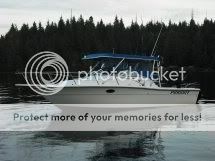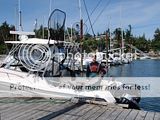anyone have any pics of their Inhull epoxied/siliconed whatever? in place transducer? Seriously thinking of going that way.
How well does it work?
Found this: Mounting Depth Finder Transducers Inside the Hull
by Tom Neale
Manufacturers frequently recommend using epoxy or similar substance if you decide to bond a transducer to the inside of the hull. They want you to use something that will set up without bubbles or voids, and that has no filler material. We never use this epoxy. If you find that you've mounted the transducer in a bad place in the hull (and you won't really know this until you start running) you're going to have a very difficult time moving it without damaging it if you've used epoxy.
We prefer to build a water box. It's relatively easy to do, the "bond" from the transducer to the hull is much better than it would be with epoxy, and you can move a water box if needed. What you use and how you do it depends upon the location and access. Usually we simply cut the bottom out of a yogurt container (or something similar), contour it, if necessary, to the hull, and seal it to the hull with a product such silicone sealant. You must remove any paint or grease that may be on the inside hull surface to obtain a good seal in that spot. We then just fill it with water and put the transducer inside. You want the transducer to be pointing down with as little variation as possible, so a container not much larger than the transducer, or the use of some other method to stabilize it, will help. Water will evaporate from the box eventually, requiring replacement. It will last longer if you cut a slit for the transducer wire in the top of the container and put the top back on the container. This will also help to support the container walls.
Location is key. It's best if the transducer is reading through a section of hull that is relatively thin and that has no voids. Thicker areas are normally found around stringers and joints, such as those where the transom and hulls join the bottom. Avoid areas where there are build ups of fiberglass tape laid around structure features. Flat planes usually give the best results. Obviously, you can't know in advance whether voids in the hull laminate exist. Tapping may give a clue if the void is large, but small voids will also interfere with your reading. They can occur in the best built boats.
It's also important that there be as little turbulence under the transducer as possible. This can be caused by many different structural or other characteristics of an outer hull surface, and the effect of a particular characteristic on turbulence can vary with speed and sea state. These are reasons why we never epoxy our transducers to the hull, and prefer to not mount them through the hull. We've found that we never really know the best location for a transducer until after we've used it under way in varying conditions.
Some manufacturers recommend against a material such as Life Calk or silicone sealant for bonding the transducer to the inside of the hull. There is greater likelihood of air pockets as the sealant sets up and it isn't as good a transmitter of the sound waves as is epoxy or water. However, we've used this successfully for temporary tests of hull locations. If you use these products, try to get as thin a layer as possible between the transducer face and the hull, and carefully mash out any air pockets. Beware that if performance isn't optimal using these sealants for testing purposes, part of the problem may stem from the use of the sealant itself. But the transducer will usually work well enough with such a sealant to let you know whether you've got a really bad area of hull. If you've found a good area, they it's easy to remove the sealant and install a water box over the spot.
See Tom's Tips in his cruising section on
www.boatus.com for information about why you might want to have a water box inside the hull, instead of a thru-hull installation and for important East Coast Alerts.




